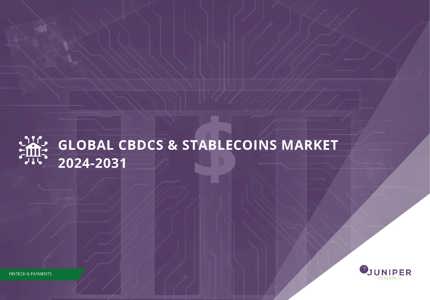FRNT and Centre: Can Wyoming’s State Stablecoin Deliver Real Value?
Wyoming has made history with the launch of the Frontier Stable Token (FRNT), the first US state-issued stablecoin. Live across seven major blockchains, including Ethereum and Solana, FRNT is backed 1:1 by US dollars and short-term Treasuries, with an added 2% over-collateralisation. This means every $1 issued is backed by at least $1.02 in reserve. Public availability is expected in September 2025, and users will be able to spend it anywhere that Visa is accepted via its integration with the Rain-issued card platform.

One standout feature is that interest earned on reserves will fund Wyoming’s School Foundation Fund; directly tying community benefits to token adoption. This is a unique model in the stablecoin space and may encourage adoption amongst state citizens - and cements Wyoming's reputation as a pro-crypto innovation hub.
But beyond the symbolism, what does FRNT really offer?
Claim: FRNT Will Provide Faster and Cheaper Transactions
The state claims that FRNT will enable faster, cheaper, and more accessible payments, with transactions settling in just a few seconds. This is made possible by blockchain technology, which processes transactions directly between users without intermediaries such as banks or payment processors. Unlike traditional systems, no bank account is required, as anyone with Internet access and a crypto wallet can acquire FRNT through the Avalanche platform, or Kraken on Solana. The blockchain also makes no distinction between domestic and international transfers; allowing cross-border payments to be made as quickly and cheaply as local ones. As a result, stablecoins like FRNT can outperform traditional bank transfers, particularly for international transactions routed through multiple banks.
However, the development of real-time payments systems, such as FedNow in the US, means that domestic bank transfers are beginning to be settled almost immediately. Other commonly used P2P payment systems in the US, such as Venmo and Zelle, are also popular by virtue of their fast settlement times and lack of settlement fees. These innovations and existing digital payment systems leave little room for FRNT to provide user value or entice users away from their familiar payment systems.
Furthermore, FRNT is integrated with Rain’s Visa card platform; allowing users to spend it anywhere that Visa is accepted, including Apple Pay and Google Pay. While this does solve the acceptance issues that tend to plague stablecoins, it also undermines one of the main touted benefits: lack of intermediaries. As one of the main points of stablecoins is direct settlement via the blockchain, using a Visa-backed stablecoin card brings card rails and their associated fees back into the equation.
Claim: FRNT Transactions Are Immutable and Provide Instant Auditability
Stablecoin transactions are inherently immutable by nature of being posted on the blockchain, which records all transactions. This makes transactions transparent and secure, as they are irreversible. However, this also introduces challenges. With no middlemen, fraud protection, refunds, and error reversals become complex; potentially exposing users to higher risk. Because of these characteristics, stablecoins have been labelled the ‘top choice’ for scam transactions.
This immutability also works against users, however; with no way to reverse the transaction, it is almost impossible to recover stolen money.
Is FRNT Too Similar to a CBDC?
The idea of a CBDC is politically contentious in the US, which passed an ‘Anti-CBDC Surveillance State Act’ in July 2025, blocking the Federal Reserve from issuing a digital dollar without Congressional approval. This is under the logic that a government-controlled CBDC would be too intrusive to the financial privacy of citizens and have the potential to restrict certain purchases such as tobacco or alcohol; representing governmental overreach.
Functionally, CBDCs and stablecoins operate very similarly, making the government issuance the main distinguisher between the two. While FRNT is not issued by a central bank, it is backed by and heavily associated with the Wyoming government. Because of this, some news publications are labelling FRNT as a ‘camouflaged CBDC’, which may prove politically unpopular. So far, state legislators are pushing hard against this narrative; framing it instead as a ‘constitutionally-protected public asset’ and highlighting its lack of ability to restrict or oversee transactions. However, the likening to CBDCs may make citizens wary of adopting FRNT.
What is FRNT's Long-term Potential?
FRNT is unlikely to gain significant traction in the domestic P2P payments market. Platforms such as Zelle and CashApp are already well-established in the US, offering fast, low-cost transfers through familiar, trusted interfaces. Without a clear advantage, Wyoming residents are unlikely to switch to a new alternative.
FRNT could offer significant value for cross-border payments, where traditional methods remain slow and costly. However, its strong ties to Wyoming and oversight by US state regulators may deter international users who prefer more globally recognised alternatives. Additionally, many individuals already using stablecoins for remittances rely on well-established options such as Tether (USDT) or Circle's USDC; making the adoption of a new, state-affiliated token less appealing. Given Wyoming’s small population of around 600,000, even widespread in-state adoption would have limited impact without broader international uptake.
The strongest use case so far is Government-to-Citizen (G2C) payouts. In July 2025, FRNT’s prototype (WYST) reduced vendor payment times from 45 days to just seconds. Future applications such as instant tax refunds, streamlined social benefits, and automated vendor payouts could offer real value to residents.
Lorien is a Senior Research Analyst in the Fintech and Payments team at Juniper Research, and specialises in analysing and forecasting emerging trends and innovations in financial markets. Her latest reports have covered topics including CBDCs & Stablecoins, Network Tokenisation, and Modern Card Issuing Platforms.
Latest research, whitepapers & press releases
-
 ReportDecember 2025
ReportDecember 2025AI Agents for Customer Experience Platforms Market: 2025-2030
Our comprehensive AI Agents for Customer Experience Platforms research suite comprises detailed assessment of a market that is set to disrupt mobile communications. It provides stakeholders with insight into the key opportunities within the AI agents for customer experience platforms market over the next two years.
VIEW -
 ReportDecember 2025Fintech & Payments
ReportDecember 2025Fintech & PaymentseCommerce Fraud Prevention Market: 2025-2030
Our eCommerce Fraud Prevention research suite provides a detailed and insightful analysis of this evolving market; enabling stakeholders from financial institutions, law enforcement agencies, regulatory bodies and technology vendors to understand future growth, key trends, and the competitive environment.
VIEW -
 ReportNovember 2025Telecoms & Connectivity
ReportNovember 2025Telecoms & ConnectivityeSIMs & iSIMs Market: 2025-2030
Juniper Research’s eSIMs and iSIMs research suite offers insightful analysis of a market set to experience significant growth in the next five years. The research suite provides mobile network operators (MNOs), original equipment manufacturers (OEMs), and eSIM management and platforms vendors with intelligence on how to capitalise on the market growth, and guidance on how eSIM-only devices and sensors, SGP.42, in-factory provisioning, and iSIMs will change the competitive landscape.
VIEW -
 ReportNovember 2025Fintech & Payments
ReportNovember 2025Fintech & PaymentsModern Card Issuing Platforms Market: 2025-2030
Our Modern Card Issuing Platforms Market research suite provides a detailed and insightful analysis of this evolving market; enabling stakeholders from banks, financial institutions, fintech companies, and technology vendors to understand future growth, key trends, and the competitive environment.
VIEW -
 ReportNovember 2025Fintech & Payments
ReportNovember 2025Fintech & PaymentsDigital Wallets Market: 2025-2030
Our digital wallets research suite provides detailed analysis of this rapidly changing market; allowing digital wallet providers to gain an understanding of key payment trends and challenges, potential growth opportunities, and the competitive environment.
VIEW -
 ReportOctober 2025Fintech & Payments
ReportOctober 2025Fintech & PaymentsDigital Identity Market: 2025-2030
Juniper Research’s Digital Identity research suite provides a comprehensive and insightful analysis of this market; enabling stakeholders, including digital identity platform providers, digital identity verification providers, government agencies, banks, and many others, to understand future growth, key trends, and the competitive environment.
VIEW
-
 WhitepaperDecember 2025Telecoms & Connectivity
WhitepaperDecember 2025Telecoms & ConnectivityHuman + AI: Drivers of Customer Experience AI Agents in 2026
Our complimentary whitepaper, Human + AI: Drivers of Customer Experience AI Agents in 2026, examines the key drivers of the AI agents for customer experience platforms market in 2025.
VIEW -
 WhitepaperDecember 2025Fintech & Payments
WhitepaperDecember 2025Fintech & PaymentsBeyond Chargebacks: The True Cost of Fraud for Digital Commerce
Our complimentary whitepaper, Beyond Chargebacks: The True Cost of Fraud for Digital Commerce, examines the state of the eCommerce fraud prevention market; considering the impact of evolving digital fraud strategies, including key trends such as identity theft, account takeovers, chargebacks, policy abuse and friendly fraud.
VIEW -
 WhitepaperNovember 2025Telecoms & Connectivity
WhitepaperNovember 2025Telecoms & ConnectivityeSIM-only Devices: The Impact on Operators, Consumers, and IoT
Our complimentary whitepaper, eSIM-only Devices: The Impact on Operators, Consumers, and IoT, explores the challenges and opportunities for the three segments, with a particular focus on eSIM-only smartphones and SGP.42.
VIEW -
 WhitepaperNovember 2025Fintech & Payments
WhitepaperNovember 2025Fintech & PaymentsUnlocking the Next Stage of Growth for Modern Card Issuing Platforms
This free whitepaper analyses key trends shaping the modern card issuing space, and the ways in which modern card issuing platforms can capture growth.
VIEW -
 WhitepaperNovember 2025Fintech & Payments
WhitepaperNovember 2025Fintech & PaymentsTop 10 Fintech & Payments Trends 2026
Fintech is evolving fast. From stablecoins to agentic AI, our annual guide reveals the shifts redefining payments, digital identity, and the future of money in 2026. Download your copy today.
VIEW -
 WhitepaperNovember 2025Fintech & Payments
WhitepaperNovember 2025Fintech & PaymentsDigital Wallets: Empowering Financial Inclusivity
Our complimentary whitepaper, Digital Wallets: Empowering Financial Inclusivity, examines the state of the digital wallets market; considering the impact of digital wallets on different geographies, how they are shaping the modern payments landscape through lower transaction fees and promoting financial inclusivity for underbanked populations, and how they are competing with established payment methods.
VIEW
-
Telecoms & Connectivity
Travel eSIM Margins Under Pressure as Revenue per Gigabyte Falls 10% Globally in Two Years
December 2025 -
Telecoms & Connectivity
AI Agents to Power 1,000% More Customer Interactions for Enterprises Globally by 2027
December 2025 -
IoT & Emerging Technology
Global D2C Revenue Set for $370 Million Surge, But Satellite Operators Should Not Chase Full MNO Status
December 2025 -
Fintech & Payments
Digital Goods Fraud to Cost eCommerce Merchants $27 Billion Globally by 2030 as AI Tools Accelerate Attacks
December 2025 -
Fintech & Payments
AML Adoption to Hit 3.8 Million Businesses Globally by 2030, With Europe at the Forefront
November 2025 -
Telecoms & Connectivity
eSIM Connections to Grow 300% Globally in Next 5 Years, as China Presents Instant Opportunities
November 2025





















